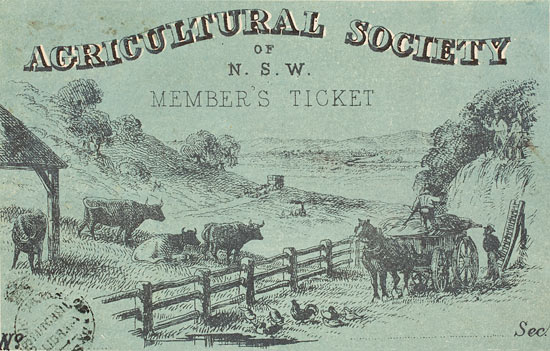Royal Agricultural Society of NSW

In 1822, the Agricultural Society of New South Wales was formed by a group of leading citizens to encourage and promote the future of agriculture through improvements in breeding of animals and the growth of local produce and crops. The society’s membership read like a who’s who of the colony at the time – leading land-owners, stock-owners and merchants, Samuel Marsden, William Cox, Hannibal McArthur, John Blaxland to name a few. It was hoped a centralised body would have the affect of raising standards in agriculture throughout the fledgling colony.
“… a public spirit of agricultural improvement shall be implanted in the breast of all” (Prospectus...of the Agricultural Society of NSW, 1822)
This pageturner requires a web browser with the Flash plugin and JavaScript enabled.
Get the latest Flash player
The Society sought to encourage and promote rural industry through competition, education and events. At its centre was the regular judging of animals and agricultural produce at an annual Show, the first of which was staged in Parramatta the following year. Despite its initial success the Society was forced to disband in 1836 due to poor economic conditions and lack of support, however it re-formed in 1857 with renewed vigour. From 1868, the Journal of the Agricultural Society of NSW was published, the first of its kind in Australia, containing practical information and latest agricultural developments for those on the land.
The annual Shows moved from Parramatta to Sydney’s Prince Alfred Park after 1868, and then to a new site at Moore Park in 1882. Although little more than scrubland at the time, it was here that the Society built a showground which would be home to the Show for the next 116 years. Only the 1919 Bubonic Plague and World War II prevented the Show going ahead in that time. The Society had been renamed the ‘Royal’ Agricultural Society of NSW in 1891, by special permission of Queen Victoria, and the first 'Royal' Easter Show was held the same year.
The Show’s competitive displays showcased the best animals and rural produce – from prize-winning cattle, sheep and pigs to fruit and vegetables exhibits, as well as displays of wood chopping, showjumping, and even ploughing demonstrations. It was also an opportunity for the exchange of ideas and practices, being an opportunity for farmers to gain first-hand knowledge of farming trends and technological advances.
By the mid 1930s, as the grip of the Depression had begun to lift, the Show’s attendance figures increased and there was a growing optimism in Australia’s agricultural future. The 1935 Royal Easter Show was the biggest to date, with the largest attendances, prize-money and competitive entries.
> View a map and photographs of Sydney's Royal Easter Show, from the 1930s
Since its inception, the Show has gone from little more than a country fair to Australia’s largest annual event attracting over a million visitors each year. In 1998 the Show moved to a new showground at Sydney Olympic Park at Homebush Bay. Bigger than ever, it now features more commercial and entertainment activities, however the promotion of our rural industries is still the mainstay of the Show. Traditionally about 'bringing the country to the city', it remains a celebration of our rural heartland.
